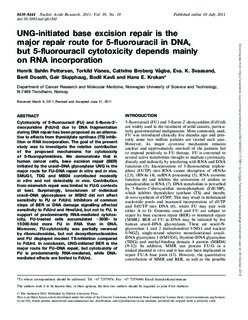| dc.contributor.author | Pettersen, Henrik Sahlin | |
| dc.contributor.author | Visnes, Torkild | |
| dc.contributor.author | Vågbø, Cathrine Broberg | |
| dc.contributor.author | Svaasand, Eva K | |
| dc.contributor.author | Doseth, Berit | |
| dc.contributor.author | Slupphaug, Geir | |
| dc.contributor.author | Kavli, Bodil Merete | |
| dc.contributor.author | Krokan, Hans Einar | |
| dc.date.accessioned | 2019-10-11T11:33:08Z | |
| dc.date.available | 2019-10-11T11:33:08Z | |
| dc.date.created | 2011-12-15T09:30:15Z | |
| dc.date.issued | 2011 | |
| dc.identifier.citation | Nucleic Acids Research. 2011, 39 (19), 8430-8444. | nb_NO |
| dc.identifier.issn | 0305-1048 | |
| dc.identifier.uri | http://hdl.handle.net/11250/2621609 | |
| dc.description.abstract | Cytotoxicity of 5-fluorouracil (FU) and 5-fluoro-2′-deoxyuridine (FdUrd) due to DNA fragmentation during DNA repair has been proposed as an alternative to effects from thymidylate synthase (TS) inhibition or RNA incorporation. The goal of the present study was to investigate the relative contribution of the proposed mechanisms for cytotoxicity of 5-fluoropyrimidines. We demonstrate that in human cancer cells, base excision repair (BER) initiated by the uracil–DNA glycosylase UNG is the major route for FU–DNA repair in vitro and in vivo. SMUG1, TDG and MBD4 contributed modestly in vitro and not detectably in vivo. Contribution from mismatch repair was limited to FU:G contexts at best. Surprisingly, knockdown of individual uracil–DNA glycosylases or MSH2 did not affect sensitivity to FU or FdUrd. Inhibitors of common steps of BER or DNA damage signalling affected sensitivity to FdUrd and HmdUrd, but not to FU. In support of predominantly RNA-mediated cytotoxicity, FU-treated cells accumulated ~3000- to 15 000-fold more FU in RNA than in DNA. Moreover, FU-cytotoxicity was partially reversed by ribonucleosides, but not deoxyribonucleosides and FU displayed modest TS-inhibition compared to FdUrd. In conclusion, UNG-initiated BER is the major route for FU–DNA repair, but cytotoxicity of FU is predominantly RNA-mediated, while DNA-mediated effects are limited to FdUrd. | nb_NO |
| dc.language.iso | eng | nb_NO |
| dc.publisher | Oxford University Press | nb_NO |
| dc.rights | Navngivelse-Ikkekommersiell 4.0 Internasjonal | * |
| dc.rights.uri | http://creativecommons.org/licenses/by-nc/4.0/deed.no | * |
| dc.title | UNG-initiated base excision repair is the major repair route for 5-fluorouracil in DNA, but 5-fluorouracil cytotoxicity depends mainly on RNA incorporation | nb_NO |
| dc.type | Journal article | nb_NO |
| dc.type | Peer reviewed | nb_NO |
| dc.description.version | publishedVersion | nb_NO |
| dc.source.pagenumber | 8430-8444 | nb_NO |
| dc.source.volume | 39 | nb_NO |
| dc.source.journal | Nucleic Acids Research | nb_NO |
| dc.source.issue | 19 | nb_NO |
| dc.identifier.doi | 10.1093/nar/gkr563 | |
| dc.identifier.cristin | 868306 | |
| dc.description.localcode | The Author(s) 2011. Published by Oxford University Press. This is an Open Access article distributed under the terms of the Creative Commons Attribution Non-Commercial License (http://creativecommons.org/licenses/ by-nc/3.0), which permits unrestricted non-commercial use, distribution, and reproduction in any medium, provided the original work is properly cited. | nb_NO |
| cristin.unitcode | 194,65,15,0 | |
| cristin.unitname | Institutt for klinisk og molekylær medisin | |
| cristin.ispublished | true | |
| cristin.fulltext | original | |
| cristin.qualitycode | 2 | |

